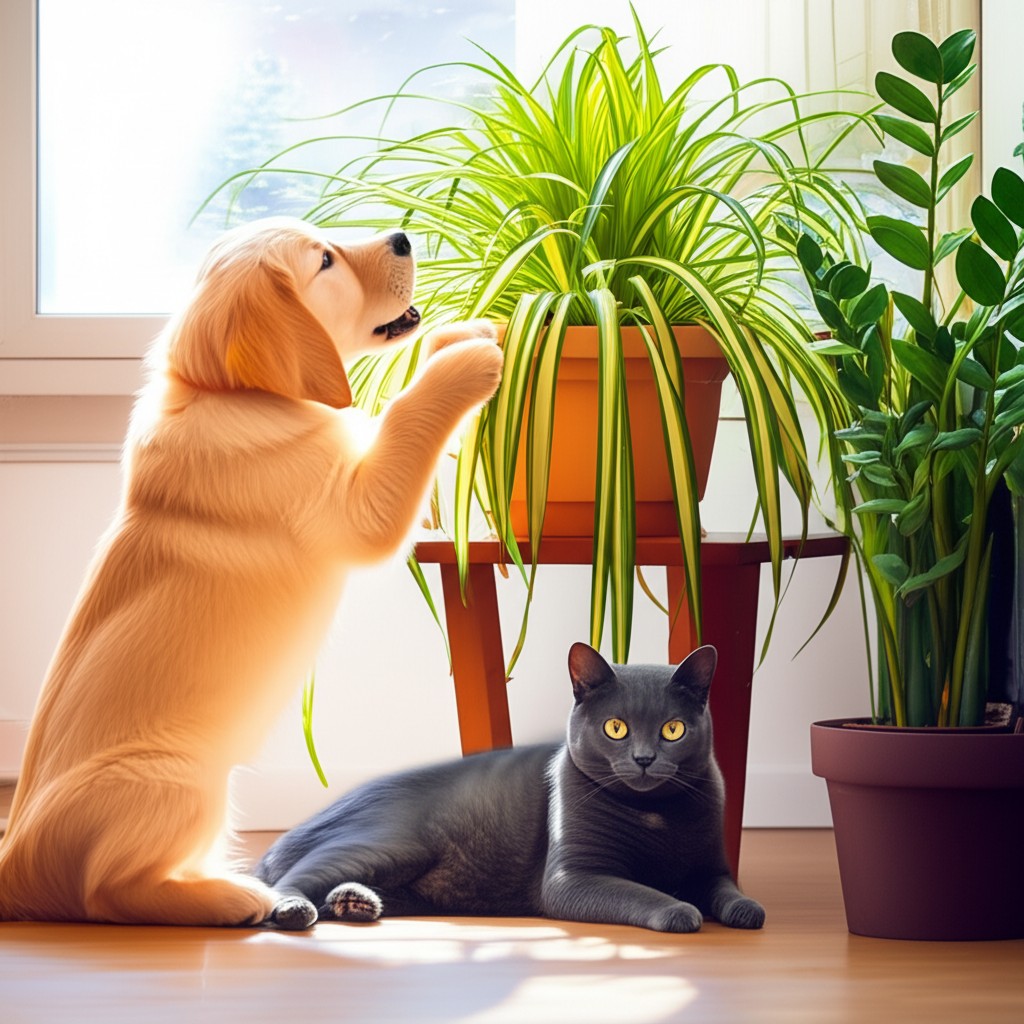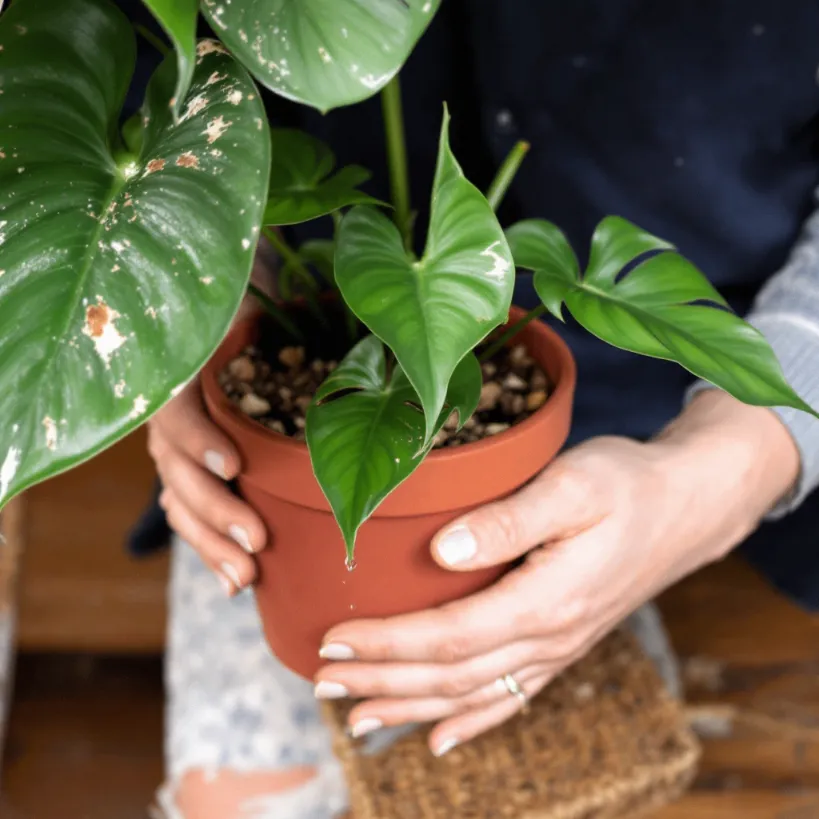Your philodendron is dripping water from its leaves because of a natural process called guttation. This happens when the plant pushes out extra water through tiny pores at the leaf tips—usually at night or early morning when humidity is high. The water droplets form when root pressure forces moisture up through the plant faster than it can evaporate.
It’s like when you drink too much water and need to pee. The plant does the same thing but through its leaves.
Key Takeaways
- Guttation is normal — water droplets on philodendron leaves mean your plant is healthy and hydrated
- It happens at night — you’ll see dripping philodendron leaves mostly in early morning hours
- Not harmful — the water won’t hurt your floors but might leave mineral spots
- Different from dew — these drops come from inside the plant, not from air moisture
- Check your watering — excessive dripping means you might be watering too much
- Temperature matters — cool nights and warm soil trigger more guttation
Understanding Water Droplets on Indoor Plants

When you spot water droplets on your beloved plant, you’re witnessing one of nature’s most fascinating processes. These drops of water appear on tropical plants like philodendrons through three main ways:
Guttation — Your plant releases excess water through special structures called hydathodes at the tips of leaf surfaces. This natural phenomenon happens when root pressure builds up overnight.
Transpiration — During the day, plants release moisture through transpiration as part of their normal breathing. High transpiration rates mean a happier plant that’s actively growing.
Dew — Sometimes those morning droplets aren’t from the plant at all. When there’s a drop in temperature, moisture condenses on the leaf surface just like on your car windshield.
For seasoned plant lovers and beginners alike, understanding these differences helps improve plant care skills and keeps your house plants thriving.
The Science Behind Philodendron Guttation
Guttation is a passive process that occurs when your philodendron can’t release moisture through transpiration fast enough. Here’s what happens inside your elegant plant:
At night, stomata close but roots keep absorbing water from the soil. This creates root pressure that pushes excess water up through the plant. The water has to go somewhere—so it exits through hydathodes as guttation droplets.
The genus Philodendron includes many species prone to this harmless process. Different philodendron varieties show varying levels of guttation based on their growth patterns and leaf structure. Arrow leaf plants and larger plants tend to drip more because they move greater amounts of water droplets through their systems.
This cool process actually shows your plant healthy and actively growing. It’s managing moisture levels exactly as nature intended.
Common Reasons for Excessive Dripping

While guttation is natural, excessive dripping might signal underlying issues with your plant care routine:
Overwatering — The most common issue. When you give more water than the evaporation rate can handle, excess moisture builds up. Check if the top inch of soil feels wet before watering again.
Poor drainage — Without adequate drainage holes, water pools at the bottom. This creates constant root pressure and excessive guttation. Ensure your pot has drainage holes and use well-draining soil.
Temperature fluctuations — A significant drop in temperature at night while soil stays warm creates perfect conditions for dripping. Consistent temperatures reduce this natural process.
High humidity — When humidity levels spike above 70%, plants can’t release water by vapour effectively. Use a humidity meter to monitor your indoor environments.
Fertilizer buildup — Excess fertilizer increases soluble minerals in soil water. Plants push out these excess minerals with water, creating more droplets.
Managing Moisture Levels in Your Philodendron
Proper moisture management keeps your low-maintenance tropical plant happy without excessive dripping:
Use the rule of thumb — Water when the top 2 inches of soil feels dry. For most philodendron species, this means watering every 7-10 days. A moisture meter takes the guesswork out of watering decisions.
Adjust your watering schedule — Water in the morning rather than evening. This gives your plant time to process extra water before nighttime guttation begins.
Check humidity preferences — Philodendrons thrive at moderate humidity levels between 50-60%. Too high, and you’ll see excess moisture buildup. Too low, and leaves might brown.
Ensure proper drainage — Mix your philodendron soil with perlite or bark for better drainage. This prevents moisture buildup at the root ball.
Identifying Different Types of Plant Droplets

Not all drops on plants are the same. Learning to identify them helps diagnose plant health:
Clear water drops — Normal guttation or dew. These evaporate cleanly without residue.
Sticky droplets — Could be honeydew from pests or drops of plant sap from injury. Check for insects under leaves.
White crusty deposits — Dried guttation droplets leave mineral residue. This indicates high levels of minerals in your water or excess fertilizer.
Yellow or brown drops — May signal nutrient issues or root problems. The plant releases waste products with excess water.
Understanding these differences helps philodendron collectors maintain their amazing plants properly.
Temperature and Environmental Factors
Environmental conditions directly affect how much your philodendron drips:
Natural temperatures matter. Philodendrons evolved in stable tropical environments. Indoor temperature swings stress the plant and increase guttation.
Humidity spikes at night reduce the evaporation rate. Droplets from guttation can become excessive in high-humidity environments.
Air circulation helps. Stagnant air around indoor plant leaves encourages moisture buildup. A gentle fan improves conditions without stressing your plant.
Light exposure affects transpiration rates. Plants in a brighter spot process more water during the day, reducing nighttime excess.
Place your philodendron away from heating vents, air conditioners, and drafty windows to maintain a stable environment.
Watering Habits That Reduce Excessive Guttation
Smart watering prevents most dripping problems:
Let soil dry a bit between waterings. Philodendrons prefer slight moisture stress over being constantly wet.
Water deeply but less frequently. This encourages healthy roots that reach down rather than staying near the surface.
Check multiple spots — Stick your finger into several areas of the pot. Sometimes one side stays wetter than others.
Adjust for seasons — Plants need less water in winter when growth slows. Reduce frequency but maintain the same watering amount when you do water.
Use room temperature water — Cold water shocks roots and can trigger stress responses including excessive guttation.
When Dripping Signals Serious Problems
While guttation is a natural process, certain signs indicate trouble:
Constant dripping during daytime suggests severe overwatering or root rot. Healthy plants only drip at night or early morning.
Foul-smelling droplets mean bacterial infection. Normal guttation water has no odor.
Wilting despite wet soil indicates root rot. Damaged roots create pressure but can’t properly feed the plant.
Yellow leaves with dripping often means the plant can’t process nutrients properly due to overwatering or poor drainage.
If you notice these signs, check your plant’s roots immediately. Healthy roots are white or cream-colored and firm. Brown, mushy roots need immediate attention.
Special Considerations for Different Plant Species
While we focus on philodendrons, understanding how other plants behave helps put things in perspective:
Monstera plants — These close relatives show similar guttation patterns. The Monstera deliciosa plant often drips more than philodendrons due to larger leaves.
Corn plants and other Dracaenas rarely show guttation despite being tropical plants. They process water differently.
Jade plants and succulents never show guttation. If you see water drops on these, check for pests or disease.
Garden plants outdoors rarely show guttation because natural evaporation and air movement prevent buildup.
This knowledge helps when caring for multiple plant species in your collection.
Creating the Perfect Environment
The ideal setup minimizes excessive dripping while keeping your plant happy:
Position wisely — Place plants where morning sun can dry droplets naturally. Avoid spots where dripping of water can damage furniture.
Group compatible plants — Nearby plants with similar humidity preferences create beneficial microclimates.
Use humidity trays — These provide local humidity without raising levels throughout the room.
Invest in proper tools — A humidity meter and moisture meter help you make informed decisions about watering and environmental adjustments.
Choose appropriate pots — Terracotta allows more evaporation than plastic, helping regulate moisture levels naturally.
Advanced Troubleshooting for Persistent Issues
When basic adjustments don’t solve excessive dripping:
Test your water — High mineral content increases guttation. Consider filtered or distilled water for sensitive plants.
Check fertilizer levels — Fertilizer burn from excess nutrients forces plants to expel minerals through guttation. Use balanced fertilizer at half strength.
Evaluate pot size — An oversized pot holds too much moisture. Philodendrons prefer slightly snug homes.
Inspect for pests — Some insects trigger excess sap production that mimics guttation. Regular inspection catches problems early.
Consider repotting — Old soil loses structure and drainage capacity. Fresh mix can solve persistent moisture issues.
Living With Natural Plant Processes
Accept that some guttation is inevitable and even beneficial:
Morning droplets indicate active growth and good hydration. They’re signs of a thriving plant, not a problem to solve.
The distribution of water droplets can tell you about air circulation and temperature patterns in your space.
Curious water droplets often appear more during growth spurts in spring and summer. This shows your plant is actively building new leaf growth.
Natural evaporation usually handles minor guttation by mid-morning. Only worry if droplets persist all day or appear excessive.
Seasonal Adjustments for Optimal Care
Your philodendron’s needs change throughout the year:
Spring — Increase watering gradually as growth resumes. Expect more guttation as the plant wakes up.
Summer — Higher temperatures increase transpiration. You might see less guttation despite watering more frequently.
Fall — Temperature differences between day and night trigger more guttation. Reduce watering frequency.
Winter — Heated homes create challenging conditions. Lower humidity might reduce guttation, but overwatering becomes more dangerous.
Making Peace With Your Dripping Philodendron
Understanding this fascinating phenomenon helps you provide better care:
Guttation is proof your philodendron efficiently manages its water needs. Those droplets on leaves show a sophisticated system at work.
Rather than fighting this natural process, work with it. Adjust your care to minimize excess while accepting some dripping as normal.
Use guttation as a diagnostic tool. Changes in pattern or amount can alert you to shifts in plant health or environmental conditions.
Remember that every plant is unique. What triggers excessive guttation in one philodendron might be perfect for another.
The Complete Care Picture
Successful philodendron care goes beyond managing water droplets:
Provide bright, indirect light for optimal growth and transpiration rates.
Maintain consistent temperatures between 65-80°F to reduce stress.
Feed monthly during growing season with balanced fertilizer to support healthy growth without excess minerals.
Prune damaged leaves promptly to prevent sap loss and maintain plant health.
Monitor for signs of mysterious plant illness beyond normal guttation.
Your philodendron will reward proper care with lush growth and manageable guttation levels. Those morning water drops become less of a concern and more of a sign that you’re doing things right.
Trust the process. Your plant knows what it’s doing—even when it makes a little mess along the way.
References
- University of Wisconsin-Madison: Guttation
- Missouri Botanical Garden: Philodendron Care
- Royal Horticultural Society: House Plant Problems
- Cornell University: Plant Physiology – Guttation
- American Society for Horticultural Science
You Might Also Like
- This concept relates closely to what we cover in our analysis of Philodendron Watering: 7 Steps for Healthy Growth (2024 Guide) Philodendron Watering: 7 Steps for Healthy Growth (2024 Guide).
- To understand this better, consider reading about Philodendron Fertilizer: 7 Expert Tips for Lush Growth (2025) Philodendron Fertilizer: 7 Expert Tips for Lush Growth (2025).
- To understand this better, consider reading about Philodendron Verrucosum Care: Expert Tips for Velvety Leaves Philodendron Verrucosum Care: Expert Tips for Velvety Leaves.